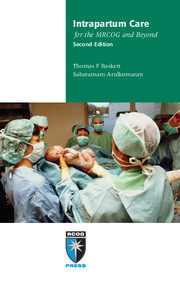Book contents
- Frontmatter
- Contents
- Preface
- Abbreviations
- 1 Improving intrapartum care
- 2 First stage of labour
- 3 Second stage of labour
- 4 Fetal surveillance in labour
- 5 Third stage of labour
- 6 Lower genital tract trauma
- 7 Induction of labour
- 8 Preterm labour and prelabour rupture of membranes
- 9 Assisted vaginal delivery
- 10 Shoulder dystocia
- 11 Breech vaginal delivery
- 12 Twin and triplet delivery
- 13 Caesarean section
- 14 Vaginal birth after caesarean section
- 15 Uterine rupture
- 16 Emergency obstetric hysterectomy
- 17 Cord prolapse
- 18 Antepartum haemorrhage
- 19 Postpartum haemorrhage
- 20 Acute uterine inversion
- 21 Amniotic fluid embolism
- 22 Disseminated intravascular coagulation
- 23 Acute tocolysis
- 24 Severe pre-eclampsia and eclampsia
- 25 Neonatal resuscitation
- 26 Perinatal loss: management of late fetal death and stillbirth
- Index
7 - Induction of labour
Published online by Cambridge University Press: 05 July 2014
- Frontmatter
- Contents
- Preface
- Abbreviations
- 1 Improving intrapartum care
- 2 First stage of labour
- 3 Second stage of labour
- 4 Fetal surveillance in labour
- 5 Third stage of labour
- 6 Lower genital tract trauma
- 7 Induction of labour
- 8 Preterm labour and prelabour rupture of membranes
- 9 Assisted vaginal delivery
- 10 Shoulder dystocia
- 11 Breech vaginal delivery
- 12 Twin and triplet delivery
- 13 Caesarean section
- 14 Vaginal birth after caesarean section
- 15 Uterine rupture
- 16 Emergency obstetric hysterectomy
- 17 Cord prolapse
- 18 Antepartum haemorrhage
- 19 Postpartum haemorrhage
- 20 Acute uterine inversion
- 21 Amniotic fluid embolism
- 22 Disseminated intravascular coagulation
- 23 Acute tocolysis
- 24 Severe pre-eclampsia and eclampsia
- 25 Neonatal resuscitation
- 26 Perinatal loss: management of late fetal death and stillbirth
- Index
Summary
Spontaneous onset of labour at term is the most desirable finale of pregnancy, heralding, as it usually does, the maturation of both fetal and maternal systems necessary for childbirth. Induction of labour is second best and this intervention is justified only for clear maternal, fetal or combined reasons. In induction of labour, uterine contractions are initiated by mechanical and/or pharmacological methods with the aim of achieving vaginal delivery. The options for induction of labour available in each centre should be discussed with the woman, including the possible success and failure rates and complications. The conditions for which induction is carried out will vary and depend on the medical or obstetric condition of the mother, the fetal condition, the knowledge and experience of the clinician, the willingness of the woman to undergo the procedure and the facilities available. Hence, the rates of induction of labour in the UK vary from 10% to 20%.
Indications and contraindications for induction of labour
There are several indications for induction of labour, the most common being:
• prolonged pregnancy (> 41 weeks)
• preterm prelabour rupture of membranes
• fetal growth restriction
• maternal conditions such as pre-eclampsia, diabetes, cholestasis or systemic lupus erythematosus
• abnormal antenatal fetal surveillance tests.
- Type
- Chapter
- Information
- Intrapartum Care for the MRCOG and Beyond , pp. 73 - 84Publisher: Cambridge University PressPrint publication year: 2011



